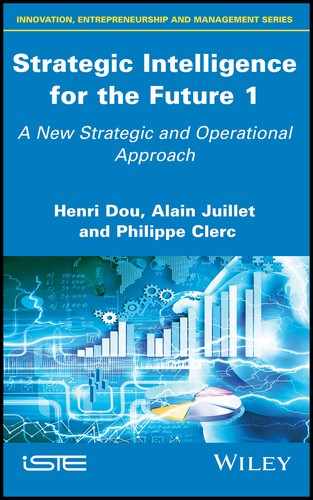Summary of Volume 2
- Preface
- Introduction
- Chapter 1. From Information Metabolism to Economic Intelligence
- 1.1. Introduction
- 1.2. Information metabolism according to Timothy Powell
- 1.3. Let us examine this concept in more detail
- 1.4. Organizations and human beings
- 1.4.1. Individuation according to Jung
- 1.4.2. Individuation according to Simondon
- 1.5. Change within organizations via the information function and an epigenetic approach
- 1.6. The zone of proximal development
- 1.7. Conclusion
- 1.8. References
- Chapter 2. Changing Our Way of Thinking
- 2.1. Plato’s cave, or the fight against the world of received ideas
- 2.2. A society without schools
- 2.3. On the intelligence cycle
- 2.4. Thinking outside the box and the iron cage
- 2.4.1. Thinking outside the box
- 2.4.2. The iron cage
- 2.5. Holistic thinking
- 2.6. Lateral thinking
- 2.7. To unravel Parkinson’s law and received ideas
- 2.7.1. Parkinson’s law
- 2.7.2. The cost of received ideas
- 2.8. The individual and their behavior
- 2.9. Thinking about the future or a return to future studies
- 2.9.1. General remarks on future studies
- 2.9.2. Foresight in business
- 2.9.3. Regional prospective
- 2.10. Conclusion
- 2.11. References
- Chapter 3. Innovation
- 3.1. Some definitions
- 3.2. The innovation mechanism
- 3.3. Different types of innovation
- 3.3.1. The development of innovation
- 3.4. Restraints on developing innovation
- 3.5. Science, technology and innovation policies
- 3.5.1. Innovation systems
- 3.5.2. A quick comparison between France and Germany
- 3.5.3. The evolution of innovation policy in the United States
- 3.5.4. Innovation in Asia
- 3.5.5. The European Union and innovation
- 3.5.6. The role of cities in innovation systems
- 3.6. Public innovation policies in France
- 3.6.1. Innovation and territories
- 3.7. Conclusion
- 3.8. References
- Chapter 4. Formal Information Research
- 4.1. The importance of the time factor in scientific data
- 4.2. Different information typologies
- 4.3. Information research
- 4.4. Research practices: reductionist, holistic
- 4.4.1. The reductionist approach
- 4.4.2. The holistic approach
- 4.4.3. Holistic approach and meta-information or metadata
- 4.5. On scientific journals
- 4.6. Conclusion
- 4.7. References
- Chapter 5. Examples of Bibliometric Analysis of Scientific Information and Patents
- 5.1. Specialist search engines
- 5.1.1. Carrot2
- 5.1.2. Wikimindmap
- 5.1.3. Newsmap
- 5.2. Scientific publications
- 5.2.1. Google Scholar
- 5.2.2. Access to Google Scholar since PoP (Publish or Perish)
- 5.2.3. The Web of Science (WoS)
- 5.2.4. Pubmed
- 5.3. Information contained in the patents
- 5.3.1. General remarks on patents
- 5.3.2. Analyzing patent information
- 5.4. Text mining from unstructured texts
- 5.5. Automatic summaries
- 5.6. Conclusion
- 5.7. References
- 5.1. Specialist search engines
- Chapter 6. Social Networks
- 6.1. Different types of social networks
- 6.2. General remarks on social networks
- 6.2.1. Why use social networks in a business?
- 6.2.2. The risks of social networks in a business
- 6.3. The dangers of social networks
- 6.4. Minimizing negative influence on social networks
- 6.5. An example of an international social network: the Confucius Institutes
- 6.5.1. Public diplomacy and Confucius Institutes
- 6.5.2. Structuring the network of Confucius Institutes
- 6.6. Examples of software enabling analysis of social networks
- 6.6.1. Analyzing tweets
- 6.6.2. Sentiment mining or opinion mining
- 6.6.3. A more general approach: analyzing tweets in social networks
- 6.7. Beyond socialbots and other IT systems, human action: fake news
- 6.7.1. The fake news dynamic
- 6.7.2. Beyond publishing online
- 6.8. You love, you “like”, you click, you evaluate, but beware of “click farms”
- 6.8.1. Calling Facebook into question?
- 6.8.2. Click farms
- 6.8.3. A new type of fake news
- 6.9. Big Data
- 6.9.1. The development of Big Data analytics
- 6.10. Conclusion
- 6.11. References
- Chapter 7. Information and Economic Security
- 7.1. Security
- 7.1.1. Physical security
- 7.1.2. Security, personnel and visitors
- 7.1.3. Security of immaterial goods
- 7.2. Disinformation and image management
- 7.3. Pressure groups and NGOs
- 7.4. IT security
- 7.5. Safeguarding data
- 7.6. Respecting security clearance
- 7.7. Crisis management
- 7.8. Conclusion
- 7.9. References
- 7.1. Security
- Conclusion
- Index
..................Content has been hidden....................
You can't read the all page of ebook, please click here login for view all page.
